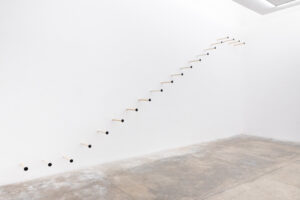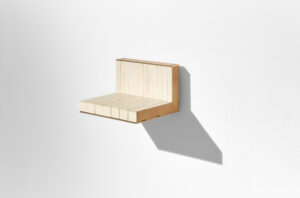In 1943 John Cage in the song entitled “A Room” composed a minimalist sound setting marked by metallic pulsations governed by a complex rhythmic system that orchestrated the sound emitted by a piano modified with bolts of different lengths, coins and other soft materials, such as rubber or fabric, whose precise location between the piano strings was detailed in the musical score. The experiments by the famous American composer were on the one hand proposed as a provocation towards the inviolability of classical instruments and on the other they opened up compositions structured by iron mathematical proportions to chance and timbral anarchy. Cage’s contribution revolutionized contemporary music with the elimination of the subjective aspect from the compositional process and with the consequent re-discussion of the foundations of perception in an anti-humanistic sense. His was an amplified and multimedia conception of the idea of music, oriented towards the irruption of the creative act into the flow of life. The concept of sound encroachment into areas usually connected to other sensorial spheres and the tension between a rigorous codification of improper procedures and the uncontrollability of the resulting poetic outcomes are also the cornerstones of the work by Jacopo Mazzonelli, a young artist from Verona who pays homage to Cage in the title of his latest solo show, currently underway at Studio G7.

Jacopo Mazzonelli, A Room, Galleria Studio G7, Bologna, photo Francesco Rucci, courtesy the artist and Galleria Studio G7, Bologna
The constant in his research, of which this project represents a significant stage for the maturity of the references put forward and for his ability to orchestrate them, is the reworking of the sound dimension understood as an integrated entity, which he constructed, manipulated and listened to to explore into which possible physical, mental and space-time components the concept of sound can be expanded and separated. Like the ideal mentor of the exhibition, Mazzonelli also bases his creative process on meticulous artisanal work applied to recycled objects (already equipped from the start with an intrinsic musical connotation, or even initially without a clear connection to this sphere), which are broken down and reassembled to explore and tangibly convey the paradigmatically immaterial implications of music. The artist, applying a stringent logic enlivened by an irony that never lapses into puns as an end in itself, establishes a relationship with the objects of his investigation that could be defined as oxymoronic. If on the one hand they are transformed by his actions into the constituent elements of a conceptual language, on the other hand they keep their essence intact despite the establishment of new semantic and poetic relationships, which indeed contribute to focusing and strengthening their identity. His works (sculptures, installations or performances) are conceived as clockwork mechanisms in which the meaning explodes at the right time, regardless of whether they are actually functioning devices or whether the movement is the mental process of those who, by looking, trigger the shift in meaning. Unlike Cage, who decisively rejected expressive intentionality, Mazzonelli instills delicate existential sensibilities into the aesthetic minimalism of his works, which transpire as if quietly to unfold gradually in contemplation and memory.

Jacopo Mazzonelli, A Room, Galleria Studio G7, Bologna, photo Francesco Rucci, courtesy the artist and Galleria Studio G7, Bologna
It is emblematic of this last aspect the environmental installation entitled “Finis”, where a series of rolls for a mechanical piano, without the roll of perforated paper that guided the automatic execution of the musical piece, appear crowded into a wall of the gallery as if they were the rungs of a ladder, which at each step reiterates the interruption evoked by the stamping of the Latin word on each of them. Here the inevitable reference to Cage’s piece 4′33”, structured in three silent movements for any musical instrument or ensemble, passes into a metaphysical idea of infinite scale (another fundamental archetype, this time of the plastic arts) and then expands as poetic suggestion in a mental space that functions as a sounding board for the form. From the infinite repetition of the end we move on to the interminable prolongation of a finite and measurable duration in “Le degré zéro”, where between two plates covered in mirrored steel (whose golden thicknesses recall the pages of a book) it is stretched, thanks to powerful internal magnets, a typewriter ink ribbon. The reflection of the iconic two-tone stripe in the two lateral elements becomes a dizzying escape towards infinity, which recalls both the idea of the pentagram as a horizontal line that runs in time and the trajectory of a sound canceled out by an impossible execution.

Jacopo Mazzonelli, Antipiano XVI, 2023, piano keys, brass, 10,2 x 16 x 14,4 cm, courtesy the artist and Galleria Studio G7, Bologna
The absence of reference points then becomes canon in “Antipiano”, a precious ivory sculpture derived from the deconstruction of a piano keyboard, a portion of which is recomposed in a tactilely disorienting way, canceling the usual relationship between white and black keys. Paradox is also the soul of “Diapason”, an object that enlarges on an environmental scale the instrument used to precisely reproduce the musical A, presented here magnified in a pastel shade that mystifies the hardness of the acrylic stone with which it is made, suggesting a ‘unnatural softness, alluding more to the absorption of sound than to its diffusion. Instead, the minimal register returns in “Noiseless”, a panel under glass in which two juxtaposed pages of a Victorian photograph album are subtly altered by a laser cut with which a circular shape is isolated in the centre, which the mismatch of the structure leads to reading as a moving disk. The work, symptomatic of the artist’s fascination with the deformations of memory, emphasizes the architectural character of the compositional structure through the assimilation of the now empty photographic spaces to the balustrades of the theater boxes.

Jacopo Mazzonelli, A Room, Galleria Studio G7, Bologna, photo Francesco Rucci, courtesy the artist and Galleria Studio G7, Bologna
The dialogue between the works on display, refinedly interwoven with conceptual, formal and procedural references, demonstrates how Mazzonelli’s research, despite being virtuosity limited to such a sectoral thematic area, is capable of developing wide-ranging suggestions and connecting them to each other with an architectural approach, arriving at an organic takeover of the exhibition space. And precisely this new design attitude that aspires to the mutual integration of the works within a unitary vision of the exhibition understood as a whole as a significant environment is the most interesting aspect of the artist’s recent creative evolution.
Info:
Jacopo Mazzonelli. A Room
10/10/2023 – 06/01/2024
Studio G7
Via Val D’Aposa 4A Bologna
Graduated in art history at DAMS in Bologna, city where she continued to live and work, she specialized in Siena with Enrico Crispolti. Curious and attentive to the becoming of the contemporary, she believes in the power of art to make life more interesting and she loves to explore its latest trends through dialogue with artists, curators and gallery owners. She considers writing a form of reasoning and analysis that reconstructs the connection between the artist’s creative path and the surrounding context.






NO COMMENT